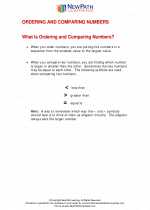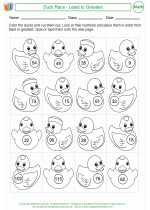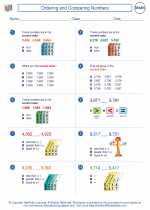Ordering and Comparing Numbers -> ascending order
Ascending order refers to arranging a set of numbers or objects from the smallest to the largest. When a group of numbers or objects is arranged in ascending order, the value or size of the items increases as you move from left to right. This can be applied to numbers, such as 1, 3, 5, 7, 9, and also to objects, such as arranging a set of books based on their heights from the shortest to the tallest.
In mathematical terms, when arranging numbers in ascending order, you compare each number in the set to every other number and place them in order from the smallest to the largest. For example, if you have the numbers 6, 3, 8, 1, and 5, arranging them in ascending order would result in 1, 3, 5, 6, 8.
To represent this concept visually, you can use an ordered list or a number line to show the progression from the smallest to the largest.
[Ascending Order] Related Worksheets and Study Guides:
.◂Math Worksheets and Study Guides Third Grade. Ordering and Comparing Numbers

 Activity Lesson
Activity Lesson
 Worksheet/Answer key
Worksheet/Answer key
 Worksheet/Answer key
Worksheet/Answer key
 Worksheet/Answer key
Worksheet/Answer key
 Worksheet/Answer key
Worksheet/Answer key
 Worksheet/Answer key
Worksheet/Answer key
 Vocabulary/Answer key
Vocabulary/Answer key
